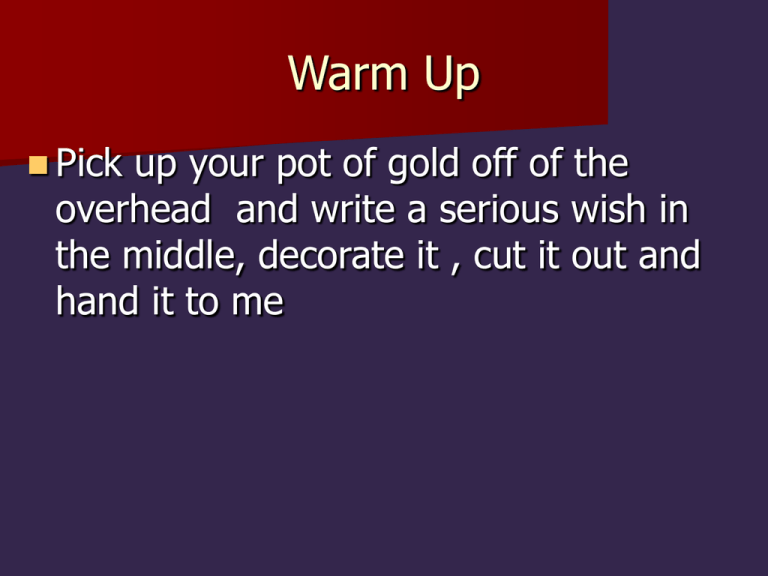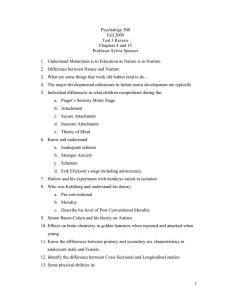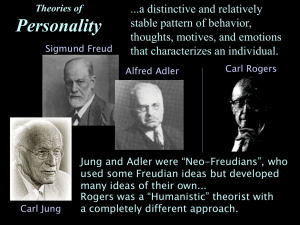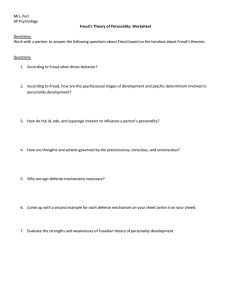
Warm Up
Pick
up your pot of gold off of the
overhead and write a serious wish in
the middle, decorate it , cut it out and
hand it to me
Chapter 15 pt. 1: Personality and
The Psychoanalytic Perspective
Personality and the Four Perspectives
Personality refers to your
characteristic pattern of
thinking, feeling, and
acting.
Four Basic Perspectives
on Personality:
1. Psychoanalytic
2. Trait
3. Humanistic
4. Social Cognitive
The Psychoanalytic Perspective
Mostly
based on the ideas
of Sigmund Freud.
Freud argued that
personality was mostly
influenced by
unconscious
conflicts/motivations
and early childhood
sexuality/experiences.
2 most basic motives were
sex and aggression.
The Psychoanalytic Perspective
Psychoanalysis:
specifically refers to
Freud’s theory on unconscious motivations
influence on our personality and to the
techniques used to uncover and
interpret unconscious conflicts and
tensions which may be causing a
psychological disorder.
From this viewpoint, only through
understanding your unconscious
conflicts can you overcome psychological
problems like depression, anxiety, etc.
Methods for Tapping Into the
Unconscious
1. Hypnosis: Freud “discovered” the
unconscious when hypnotizing his
patients. Under hypnosis patients would
talk freely about the onset of their
symptoms and their lives which allowed
Freud access to “unconscious conflicts.”
Freud eventually turned away from
hypnosis since not all patients reacted to
it.
Methods for Tapping Into the
Unconscious
2. Dreams: considered the
“royal road to the
unconscious.”
Manifest content (dream
sequence) was a censored
expression of the dreamer’s
unconscious wishes called
latent content which can
be analyzed by
psychoanalysts.
Methods for Tapping into The
Unconscious
3. Free Association:
technique in which
patients relax and say
whatever comes to
their mind without
censoring themselves no
matter how trivial or
embarrassing the flow of
thoughts is.
Methods for Tapping into The
Unconscious
To
Freud nothing you did or said was ever
accidental; Everything offered insights
into the unconscious.
4. Freudian Slips: slips of the tongue or
actions which may illustrate unconscious
motives/feelings.
Ex: Accidentally calling your wife “mom”
Man sending a post card to his wife
while on vacation which reads: “Wish
you were her.”
Unconscious vs. Preconscious
Unconscious:
According to Freud is a reservoir of mostly
unacceptable thoughts, wishes,
feelings and memories we are unaware
of.
Contemporary viewpoint- information
processing of which we are unaware
Preconscious: information that is not
conscious, but is retrievable into conscious
awareness. Ex: phone number, best
friend’s last name, etc.
Structure of Our Personality
According to Freud
To
Ego
Conscious mind
Unconscious
mind
Superego
Id
Freud,
Personality is like
an iceberg.
Only can see
very small part
of it (conscious)
while most of it
is unseen
(unconscious)
Parts of Personality According
to Freud
1.
Id: largest part of your
personality that is
unconscious, largely
instinctual, and purely
operates to satisfy
biological, sexual, and
aggressive drives.
Seeks immediate gratification
and operates according to the
pleasure principle.
Parts of Personality According to
Freud
2. Superego: part of
personality that develops
around the age of 4 to 5.
Is your voice of conscience
and focuses on how you
ought to behave according
to the ideal.
Provides standards for
judgment and future
aspirations; pushes you
towards perfection.
Parts of Personality According
to Freud
3.
Ego: the largely
conscious part of your
personality that mediates
conflict between your id
and superego.
Operates according to the
reality principle satisfying
the id’s desires in ways that
will realistically bring
pleasure rather than pain.
Your Personality Arises From Conflict
Between Pleasure Seeking Impulses and
Internalized Social Restraints Against Them
Personality Development
According to Freud, personality developed
during the life’s first few years. He believed that
Adult’s conflicts are rooted in unresolved
conflicts from early childhood which were
often related to conflicts in psychosexual
development.
Psychosexual Stages: childhood stages of
development during which according to
Freud, the id’s pleasure seeking energies are
focused on distinct erogenous zones.
Know the Psychosexual Stages
Freud’s Psychosexual Stages
Stage
Focus
Oral
(0-18 months)
Pleasure centers on the mouth-sucking, biting, chewing
Anal
(18-36 months)
Pleasure focuses on bowel and bladder
elimination; coping with demands for
control
Phallic
(3-6 years)
Pleasure zone is the genitals; coping with
incestuous sexual feelings
Latency
(6 to puberty)
Dormant sexual feelings
Genital
(puberty on)
Maturation of sexual interests
Conflict During the Phallic
Stage
The
Oedipus Complex: boys develop
sexual desires towards their mothers
and feelings of jealousy and hatred
towards their father
Fear of punishment from their father leads
to castration anxiety and eventual
repression of feelings towards mother and
identification with rival parent (father).
Electra Complex: similar process some
psychoanalysts feel women feel towards
their fathers and mothers.
Personality Development and
Conflict
Identification:
process by which
children incorporate their parents’
values into their developing superegos.
Fixation: refers to a lingering focus of
pleasure seeking energies at an earlier
psychosexual stage. Occurs when
those sexual needs are overindulged
or deprived.
–Ex: Anal Retentive, etc.
Personality and Dealing with
Anxiety
The
ego has to deal with a variety of
forms of anxiety based on unconscious
conflicts and the conflicting desires of id
and superego. At times to avoid
anxiety it looks to protect itself by
using:
Defense Mechanisms: methods that
the ego uses to reduce anxiety.
Involves unconsciously distorting reality to
make itself feel better.
Examples of Defense Mechanisms
1. Repression: banishes anxiety-arousing
thoughts, feelings, and memories from
consciousness.
– Ex: Child Sexual Abuse is “forgotten.”
2. Regression: when an individual retreats
to an earlier more infantile psychosexual
stage, where some psychic energy remains
fixated.
– Ex: When stressed someone may smoke or
drink more (oral fixation).
Examples of Defense Mechanisms
3. Reaction Formation: when the ego
unconsciously switches unacceptable impulses
into their opposites. People will express
opposite of their anxiety arousing feelings.
Ex: Those with Unacceptable homosexual
impulses may become gay bashers.
4. Projection:
when people disguise their
own threatening impulses by attributing
them to others.
Ex: Husband who is cheating may constantly
accuse wife of the behavior.
Examples of Defense Mechanisms
5. Rationalization: offering selfjustifying explanations in place of the real,
more threatening, unconscious reasons for
one’s actions.
Ex: Justifying Cheating on Taxes by saying the
government would use $ to create nuclear
weapons.
6. Displacement:
shifting one’s sexual or
aggressive impulses to a more acceptable or
less threatening object or person…redirect
anger at “safer outlet.”
Ex: Angry at boss or supervisor and you take
it out by yelling at spouse.
Examples of Defense Mechanisms
7. Sublimation: when people rechannel
their unacceptable impulses into socially
approved activities.
Ex: Playing football to rechannel aggressive
impulses.
*8. Intellectualization: separating oneself
from emotional impact of a situation by
focusing on problem in systematic factual
way or in the abstract.
Ex: A wife who learns her husband is dying
tries to learn all she can about the disease,
prognosis, treatment options. Look at it in
scientific way to avoid emotion.
Examples of Defense Mechanisms
*9. Denial: when person denies threatening
behavior or events are taking place.
Ex: Person who is in a horrible accident states
emphatically “I will walk again!”
*10. Undoing: idea that if you have
unacceptable impulses/behavior you can undo
or make it up by doing something.
Ex: After cheating on wife, husband buys her
jewelry.
DEFENSE MECHANISM HANDOUT.
Psychoanalytic Personality Tests:
Assessing the Unconscious
Projective
Tests: test which
presents ambiguous (unclear) stimuli
which is designed to get at one’s
inner/unconscious dynamics when you
interpret it.
WHAT DO YOU SEE?
Types of Projective Tests
Thematic
Apperception
Test (TAT): test
where people
express their inner
feelings and
interests through
the stories they
make up about
ambiguous
scenes.
Types of Projective Tests
Rorschach
Inkblot Test: most
widely used projective test, looks to
identify people’s inner feelings by
analyzing their interpretations of blots.
Neo- Freudians
Supporters
of Freud
Had 2 major differences with
Freud
1. They placed more emphasis on
the conscious mind
2. Doubted the role of sex and
aggression
Alfred
Neo-Freudians
Adler: emphasized the
importance of SOCIAL
tensions in childhood rather
than sexual tensions to explain
personality development.
Proposed idea of inferiority
complex: feeling of inferiority
during childhood which causes
individuals to overcompensate
and either have significant
achievements or develop
antisocial tendencies.
Neo-Freudians
Carl Jung: Came up with several important
Psychoanalytic ideas including:
1. Collective Unconscious: idea that
humans have a shared reservoir of memory
traces from our species’ history.
2. Complex: unconscious impulses that lie
behind an individuals mysterious behavior. At
core of complex was idea known as
Archetype: universal pattern of experience.
Example of Archetypes:
– A. Anima/Animus: feelings towards
opposite gender
Criticism of Psychoanalysis?
Development
is not just in
childhood
Overestimated parental
involvement
Might have created false
memories in patients
Is Repression a Myth?









